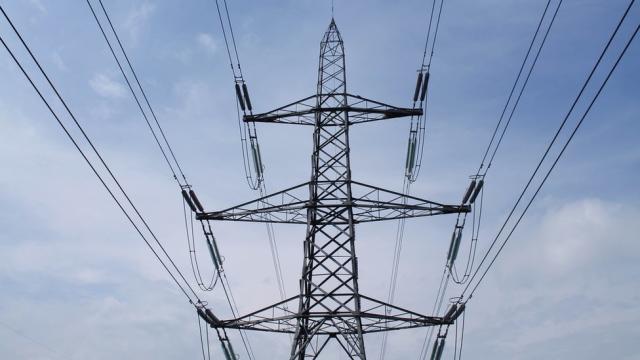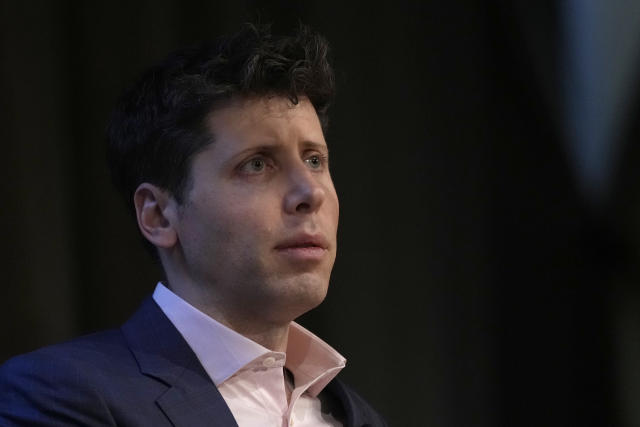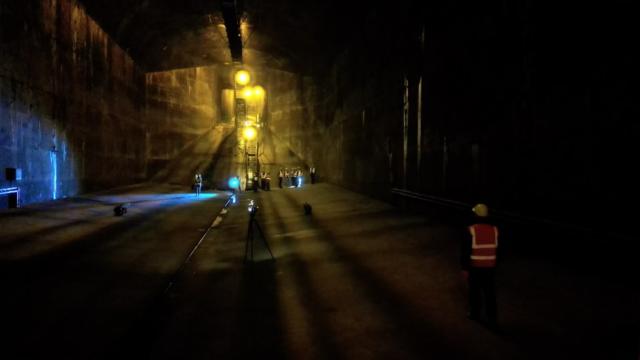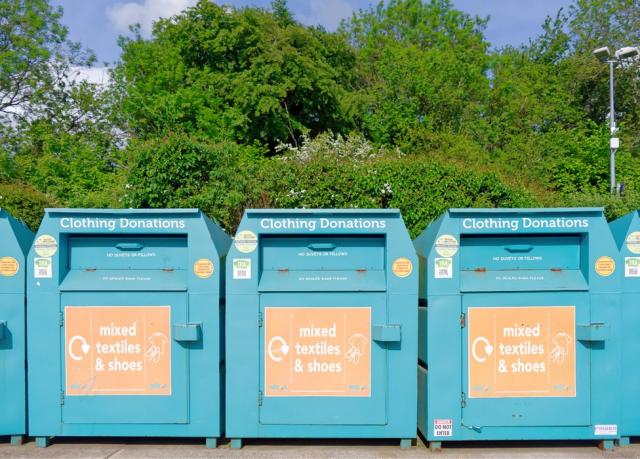Science Daily News | 31 May 2023

Views (177)

Plans to build electricity link between Scotland and NI
Transmission Investment aims to represent over 40% of the winter peak demand in Northern Ireland.

Plans have been announced to build a new electricity link between Scotland and Northern Ireland.
The company behind the scheme, Transmission Investment, has applied for an electricity transmission licence.
That is one of the first regulatory hurdles the project must pass.
If that was delivered it would represent over 40% of the winter peak demand in Northern Ireland.
LirIC project director Keith Morrison said: "The application for a transmission licence is an early milestone in a long process but it's significant in that it moves us one stage closer towards delivering this very exciting project."
The plans comprise two convertor stations, one in Northern Ireland and another in Scotland, and a cable length of around 130km (80 miles) linking the two, depending on the final route.
The company said potential routes and locations were being studied in detail.
It said the scheme represents a potential investment of about £700m.
Martin Doherty of the Centre for Advanced Sustainable Energy at Queen's University Belfast said it was "vitally important that Northern Ireland strengthens its interconnectivity with our partners both in Great Britain and Ireland".
There are also long-delayed plans to build an interconnecter between NI and the Republic.
In a subsequent court challenge, a High Court judge refused to overturn planning permission, despite identifying a legal flaw in the decision-making process.
Local campaigners continue to lobby against the project.
Artificial intelligence raises risk of extinction, experts say in new warning
Scientists and tech industry leaders, including high-level executives at Microsoft and Google, issued a new warning Tuesday about the perils that artificial intelligence poses to humankind. “Mitigating the risk of extinction from AI should be a global priority alongside other societal-scale risks such as pandemics and nuclear war,” the statement said. Sam Altman, CEO of ChatGPT maker OpenAI, and Geoffrey Hinton, a computer scientist known as the godfather of artificial intelligence, were among the hundreds of leading figures who signed the statement, which was posted on the Center for AI Safety's website.

“Mitigating the risk of extinction from AI should be a global priority alongside other societal-scale risks such as pandemics and nuclear war,” the statement said.
The latest warning was intentionally succinct — just a single sentence — to encompass a broad coalition of scientists who might not agree on the most likely risks or the best solutions to prevent them, said Dan Hendrycks, executive director of the San Francisco-based nonprofit Center for AI Safety, which organized the move.
“There’s a variety of people from all top universities in various different fields who are concerned by this and think that this is a global priority,” Hendrycks said. “So we had to get people to sort of come out of the closet, so to speak, on this issue because many were sort of silently speaking among each other.”
He compared it to nuclear scientists in the 1930s warning people to be careful even though “we haven’t quite developed the bomb yet.”
“Nobody is saying that GPT-4 or ChatGPT today is causing these sorts of concerns,” Hendrycks said. “We’re trying to address these risks before they happen rather than try and address catastrophes after the fact.”
“Given our failure to heed the early warnings about climate change 35 years ago, it feels to me as if it would be smart to actually think this one through before it’s all a done deal,” he said by email Tuesday.
An academic who helped push for the letter said he used to be mocked for his concerns about AI existential risk, even as rapid advancements in machine-learning research over the past decade have exceeded many people’s expectations.
David Krueger, an assistant computer science professor at the University of Cambridge, said some of the hesitation in speaking out is that scientists don’t want to be seen as suggesting AI “consciousness or AI doing something magic,” but he said AI systems don’t need to be self-aware or setting their own goals to pose a threat to humanity.
“I’m not wedded to some particular kind of risk. I think there’s a lot of different ways for things to go badly," Krueger said. "But I think the one that is historically the most controversial is risk of extinction, specifically by AI systems that get out of control.”
___
O'Brien reported from Providence, Rhode Island. AP Business Writers Frank Bajak in Boston and Kelvin Chan in London contributed.
Norwich: Overgrown grass verge sparks roundabout safety fears
Drivers fear the uncut grass verges by the Longwater Retail Park in Norwich could cause accidents.

Drivers have raised concerns that overgrown grass on a busy roundabout could cause accidents.
The roundabout links the A47 to the Longwater Retail Park on the western edge of the city.
Norfolk County Council, which maintains the roadsides, said it wanted to keep the verges "free for the wildlife".
Graham Plant, from the council, said: "There's a fine balancing act, but we do take safety as a priority."
It said if a problem was identified, the area would be cut normally within a day or two.
However, one BBC radio listener said: "When you're approaching the roundabout and trying to exit you can't see what's beyond the roundabout because there's no visibility due to how long the grass is."
Another shared how he had spotted a "dicey moment" as a driver pulled out just as a car was coming round the junction - with the view limited by the overgrown grass.
Conservative councillor Mr Plant, cabinet member for highways, infrastructure and transport, said he was unaware of any issues at the junction, but said the wet weather spell had resulted in fast-growing vegetation.
"There are protocols set for safety on a highway - if it is dangerous or proves to be dangerous - then it would be cut," he said.
"The safety element of it has to be the prime reason.
"We are working with the environment and trying to keep the grass verges... free for the wildlife."
Mr Plant said the visibility from certain junctions was worked out over years and verges were then cut back on average about four times a year.
Norfolk Wildlife Trust (NWT) said leaving grass verges to grow boosted nature and wildlife, but that safety was still key.
Conservation officer Sam Brown, from the charity, said there were now 100 road verge nature reserves in Norfolk and they hoped the number would triple.
She said the NWT worked in partnership with the county council to increase biodiversity in these roadside stretches, but appreciated that people sometimes found them untidy.
"We totally support verges being cut where health and safety and visibility is an issue," said Ms Brown.
"We totally support the rest of the verges being uncut from April/May through to August/September because they can support an amazing diversity of plants - you get all sorts of quite scarce plants in Norfolk.
"These flowers support pollinators, all sorts of bat, birds and small mammals. They act as corridors and refuges for wildlife as they're travelling across the landscape."
Inside Jersey's man-made cave stopping sea pollution
The "cavern" keeps sewage out of the sea during heavy rainfall.

Beneath a St Helier car park, a giant feat of engineering is increasingly at the forefront of Jersey's response to climate change.
Carved out of granite in the mid-1990s, the cavern stores overflows of sewage and rainwater during storms, stopping pollution spilling into St Aubin's Bay.
It is currently used an average of 50 to 80 times a year.
With more extreme weather expected in the future, the vast space could be used more often.
A smaller, second cavern is due to be built by the end of 2023, while the government is considering whether a number of additional storm-water storage tanks might also be needed.
Dimly-lit and lined in dank, dark concrete, the subterranean structure, which can hold about 25,000 cubic metres of waste, was substantially completed in 1997.
Since then, it has helped Jersey's Bellozanne Sewage Treatment Works to cope when wet weather increases the pressure on an ageing drainage network already contending with the requirements of a growing population.
"If we get high rainfall events, we get high sewage flows which Bellozanne can't treat. Before the cavern was built that would have gone out to sea," said Duncan Berry, head of liquid waste for the Government of Jersey.
"Now, the cavern will take those flows and store it and we can empty it back into the sewer system when there's capacity at a later date."
"Obviously, we're looking at constantly investing, we need more money to look at developing the island," Mr Berry said.
"There's a lot of new houses being built, so whilst we're building a new sewage treatment works, we now need to look at the network - to expand the network, to increase the capacity - so there will probably be a lot more mini-caverns around the island, but just for foul water.
"We are currently looking at all our surface water management plans to allow for climate change in the future."
As tall as Jersey's air traffic control tower and so big that you would need to flush your loo almost three million times to fill it, the cavern is accessed via large double doors in the centre of Snow Hill car park.
It undergoes an annual clean, during which a team of up to eight people dressed in full protective gear spend about three weeks spraying its surfaces with fire hoses.
With the help of automated pumps, sludge is then collected and transported to La Collette for incineration.
Staff said that the process often uncovered multiple items hidden in the murky water, from food wrappers to wet wipes, while a cannon ball and live toads were amongst the more unusual discoveries.
"Cleaning it was very difficult back in the dark ages," said pumping station operator Rob Lightfoot, who has worked in the cavern since it was built.
"It was very much manual handling and lots and lots of members of staff.
"Now, the team is relatively small and we've got some fantastic equipment that helps us get our job done."
And while the project initially proved controversial, more recently, it has been the subject of praise.
"It's saved hundreds and hundreds of spills to the island," said Mr Berry.
"It was a brave decision to build it. We don't have much land in Jersey, so it's probably the only solution we had.
"This is an asset that's going to last for hundreds of years to come."
High Wycombe: Can people really fall in love with their local tip?
What is it about a Buckinghamshire waste centre that earned it a 100% satisfaction rating?

"The staff here are pleasant, polite and helpful," says David Eggleton. "You even get celebrities who come here, so it must be good."
The "here" to which Mr Eggleton refers is neither a luxury shop nor a posh restaurant.
It is High Wycombe's household waste and recycling centre.
And Mr Eggleton, who runs ABC House Clearance, is far from alone in holding this particular civic amenity site in such high regard.
"It does everything well and ticks all of the boxes," says Mr Eggleton. "I'm in the trade so I use a lot of tips and this one stands out above the rest of them.
"On one occasion actor David Jason was here getting rid of an old printer and everybody rushed over to him to get their pictures taken.
"They even help people if they see people struggling with things, it is a clean site and they work in all weathers. They couldn't be more efficient.
"At other tips, they sometimes won't take furniture if it has got fabric on it and so on - so they won't take office chairs or headboards or the like.
"Here they take it all and what tips need to understand is that, if you do all types of waste, it will reduce the fly-tipping."
Jackie Ward, chief executive at South Bucks Hospice, goes one step further than Mr Eggleton.
"I do love the recycling centre," she says, "I think it is a really good site.
"I've lived in Wycombe all my life and this site has developed massively over the years. It is so efficient now and the staff are really lovely and helpful."
Unusually for a household waste and recycling centre, the High Wycombe site has a hospice shop within its grounds.
Members of the public bring useable items they no longer need to be resold to raise money for the community hospice, which employs about 20 staff, sees about 600 patients each year and runs a lymphedema clinic.
The shop here is managed by Gary Pritchard.
"The stuff that people are ready to throw away can be unbelievable," Mr Pritchard says.
More unusual items on display include a church pew complete with knee pads, a set of skis and an old (thankfully empty) military explosives box.
At the moment, the shop is seeing an influx of gardening items, including lawn mowers, furniture and pots.
"They come and go like hot cakes," Mr Pritchard says. "We need these types of sites all over the country."
Some wonder whether the reuse shop is almost too popular, with some visitors known to return up to three times a day and lay in wait for items to be delivered.
Mr Pritchard says he has occasionally has to ask such people to keep visits to a maximum of twice daily.
Brian Pearce is visiting the centre to drop off green waste and metal items and offer an old ammunition box to the hospice shop.
"It is easy to get to," he says. "Twenty years ago we had problems with the recycling of green waste - it was awful, the whole area smelled terribly. They've sorted that, you can't smell anything here now.
"The staff are very friendly and very good."
Nobody the BBC spoke with at the site raised any criticisms or concerns about the operations here.
Such praise and attention, though welcome, leaves the site's team leader and machine operator Matt Hodgson a little bemused.
"It is a good feeling," he says in response to some of the compliments paid to him and his seven-strong team.
"We all get on and we've got a good team here."
Mr Hodgson, who has worked at the centre for nearly 12 years, says putting on a smile can be a challenge at the centre's busiest times and in the depths of winter.
But they are helped along, he says, by the various regulars - particularly tradespeople - who "are friendly and like to have a little chat".
Is there a recipe for a "good" waste and recycling centre? Jilly Jordan, the council's deputy cabinet member for environment, thinks there is.
"Waste and recycling centres used to be horrible places," she says.
Making a good one, she says, starts with placement.
In 2022, the High Wycombe site, managed by FCC Environment, diverted 114 tonnes of waste items to the hospice shop
The most complained about issue in the recent customer survey, completed by 2,325 visitors, concerned road signs to the the county's recycling centres - 2% said they were "not satisfied"
Buckinghamshire's 10 waste and recycling centres deal with about 43,000 tonnes of waste each year
About 66% of all waste delivered at the High Wycombe centre was recycled last year
Set on the outskirts of High Wycombe, the centre is almost hidden by the tall trees that surround it on three sides. Despite being on the periphery, 66% of visitors say they can reach the centre within 10 minutes.
"The staff here are amazingly friendly and care about what they do," says Ms Jordan. "There's a rhythm here and it all just works."
Asked whether she loves this particular centre, Ms Jordan's political savvy comes into play.
"Maybe love is not quite the right word. We certainly take great pride in this centre.
"They have got it right here and this is an ideal place to come for anybody wanting to know how to get a job done and get it done well."
China launches new crew for space station, with eye to putting astronauts on moon before 2030
China launched a new three-person crew for its orbiting space station on Tuesday, with an eye to putting astronauts on the moon before the end of the decade. The Shenzhou 16 spacecraft lifted off from the Jiuquan launch center on the edge of the Gobi Desert in northwestern China atop a Long March 2-F rocket just after 9:30 a.m. (0130 GMT) Tuesday. The crew, including China’s first civilian astronaut, will overlap briefly with three now aboard the Tiangong station, who will then return to Earth after completing their six-month mission.

The Shenzhou 16 spacecraft lifted off from the Jiuquan launch center on the edge of the Gobi Desert in northwestern China atop a Long March 2-F rocket just after 9:30 a.m. (0130 GMT) Tuesday.
The crew, including China’s first civilian astronaut, will overlap briefly with three now aboard the Tiangong station, who will then return to Earth after completing their six-month mission.
A third module was added to the station in November, and space program officials on Monday said they have plans to expand it, along with launching a crewed mission to the moon before 2030.
China’s first manned space mission in 2003 made it the third country after the former Soviet Union and the U.S. to put a person into space under its own resources.
On the this latest mission, payload expert Gui Haichao, a professor at Beijing’s top aerospace research institute, will join mission commander Maj. Gen. Jing Haipeng, who is making his fourth flight to space, and spacecraft engineer Zhu Yangzhu.
The crew will stay aboard the station for around five months, during which they will conduct scientific experiments and regular maintenance.
The mission comes against the background of a rivalry with the U.S. for reaching new milestones in space. That has been largely friendly, but also reflects their sharpening competition for leadership and influence in the technology, military and diplomatic fields.
American spending, supply chains and capabilities are believed to give it a significant edge over China, at least for now. China has broken out in some areas, however, bringing samples back from the lunar surface for the first time in decades and landing a rover on the less explored far side of the moon.
The U.S., meanwhile, aims to put astronauts back on the lunar surface by the end of 2025 as part of a renewed commitment to crewed missions, aided by private sector players such as SpaceX and Blue Origin.
In addition to their lunar programs, the two countries have also separately landed rovers on Mars, and China plans to follow the U.S. in landing a spacecraft on an asteroid.
0 Likes
